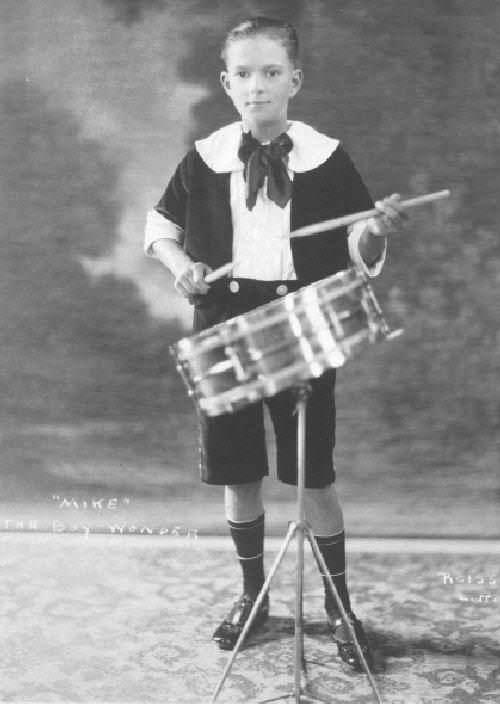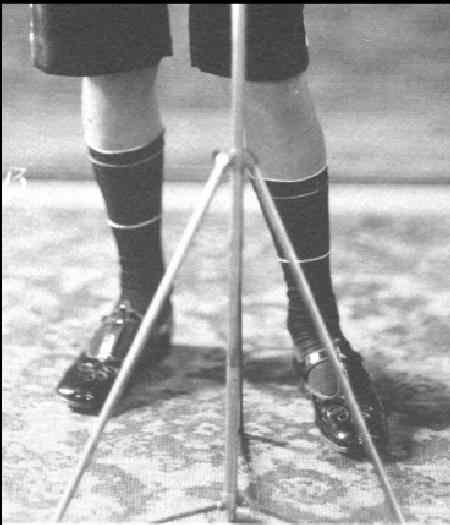
Prodigy/Recital Outfit--Mike (United States, early 1920s)

Figure 1.--This boy's name was Mike. HBC estimates that this portrait was made in the early 1920s for a recital, although he may have been a minor prodigy. Unfortuntaley we have no information on the orovinamve of this portrait, except that it is probably American. For a more detailed analysis of the boy's outfit, click on the image.
|
HBC has no details about the provinance of this portrait. We believe that the boy is American. He is probably having his portrait taken before or after a music reciatal in an outfirt his mother created. It is possible, however, that he was a minor prodigy involved in show business. This is suggested by the inscription on the portrait, "Mike, the Boy Wonder". We believe the poortrait was taken in the early 1920s. Interestingly, while the boy presumably had little to say about his outfit, he almost ceratinly selected the drums himself. It seems unlikely that the mother who chose this outfit would have chosen the drums for her aspiring musician.
Chronology
The background has the look of portraits taken in the 1910s. The short pants are more common in the 1920s. Kneepants woukld have been more likely in the 1910s. These longer shorts suggest the eearly 1920s. While we believe this portrait was taken in the 1920s, it probably was the very early 1920s, perhaps 1920-23.
Location
We do not have any details on the location, but we believe it be an American image. It is in an American collection. In addition, we have seen other comparable outfits from the early 18920s that we know are Anmerican images.
The Boy
The boy looks to be about 11 years old, perhaps 12. Unfortunately we have no other information about him. It does appear that he had an adoring mother, perhaps a stahe mother promoting his show business career. Interestingly, while the boy presumably had little to say about his outfit, he almost ceratinly selected the drums himself. It would be interesting to know just how such matters were settled in the family. By the 1920s American boys were exerting more influence over their clothes, although mothers still had much more say than is the case with the modetn family. It seems unlikely that the mother who chose this outfit would have chosen the drums for her aspiring musician.
The Outfit
The Fauntleroy suit was a 19th century fashion thay continued into the early 20th century. Actuaal Fauntleroy suits were not commonly seen after World War I (1914-18), the style began to be seen as frivolous. We do, however, notice boys outfists that have eklements of the Fauntleroy style, especailly during the early 1920s. Mothers often used such styling in the early 1920s, although by the end of the decade more standard suits styles had become more common at reciatals.

Figure 2.--This is the earlist example of a boy wearing dressy "T" strap shoes that HBC has noted. More common were pkain single bar strap shoes. Nore te tear-drop cut outs..
|
This boy's mother has employed several very juvenile styles for his performance costume. He has a very wide white collar and bow. This was a style still seen for very young boys in the eraly 1920s, but less commonly for a boy this age. The collar is especially wide. The jacket has shortened sleeves. He wears short pants. Although they are long like kneepants, there do not seem to be ornamental buttons at the hem. The blouse and pants are the button on style. The button-on style was commonly made in sizes up to 10 years, but usually not in such dressy styles and such large buttons. He also wears "T" strap patent leather shoes. Boys in such outfits often wore strap shioes, but not normally "T" straps. This is the earliest image HBC has noted of a boy wearing dressy patent-leatherr T-straps. HBC suspects that the the oitfits were made by the mothers involved rather than purchased in a store.
As opposed to the classic Fauntleroy suit, this outfit has the look of a costume that was worn specifically for the recital, but perhaps not for other dress occasions like parties and church--but HBC is not positive about this.
The Portrait
Fortunately, many mothers dressing their sons in fancy outfits wanted to preserve a record of their young prodigies, so there are many portraits available of such outfits. As the Fauntleroy suit had gone out of style, these outfits are quite individualistic and demonstrate considerable creativity on the part of the motther.
Circumstances
There appear to be two alternative possibilities for this portrait. The first is that he is probably having his portrait taken before or after a music reciatal in an outfirt his mother created. The second is that he may have been a minor prodigy involved in show business. This is suggested by the inscription on the portrait, "Mike, the Boy Wonder". This may be a publicity prtrait.
A HBC reader comments, "I would guess he was a performer, because although I don't have a date for the photo, I think even when "Buster Brown" suits were in style, this boy
would actually be a little too old to dress in one as every day clothing.
Since he looks to be at least 12 or 13 years old, my guess is that his
parents or agent made him dress in a more juvenile-looking short pants suit
so it would be an easier task to convince an audience that he is more of a
prodigy. I made a closer scan of the mid-calf socks and "mary jane" type
shoes, because I think this makes the outfit appear even more juvenile for a
boy his age."
Christopher Wagner

Navigate the Historic Boys' Clothing Web Site:
[Return to the Main inter-war years instrumental music recital Fauntleroy style page]
[Return to the Individual prodigy page]
[Introduction]
[Activities]
[Bibliographies]
[Biographies]
[Chronology]
[Clothing styles]
[Contributions]
[FAQs]
[Glossaries]
[Boys' Clothing Home]
Related Chronolgy Pages in the Boys' Historical Web Site
[Main Chronology Page]
[The 1880s]
[The 1930s]
[The 1940s]
[The 1950s]
[The 1960s]
[The 1970s]
[The 1980s]
Navigate the Historic Boys' Clothing Web style pages:
[Fauntleroy suits]
[Kilts]
[Caps]
[Sailor suits]
[Sailor hats]
[School uniform
[Scout
Created: October 10, 2001
Last updated: October 10, 2001




